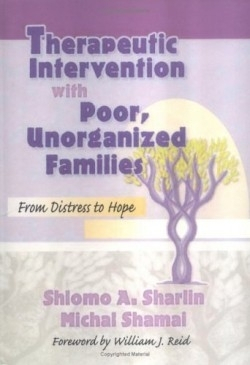Therapeutic Intervention With Poor, Unorganized Families
From Distress to Hope
Imagine arriving for a meeting at a client’s home only to be greeted by a mother still in her nightclothes, clearly not prepared for the visit; or a husband drunk and sleeping off a fight with his wife. Imagine sessions where children and parents resort to swearing and abusing each other; where a member of the family faces imminent arrest. As many social workers know, such scenarios are not uncommon when working with poor, multi-problem families.
Presenting a model developed from research conducted in Israel with the cooperation of the Department of Social Services, Drs. Sharlin and Shamai share their toolbox for working with the families every social worker dreads—which they call FEDs—families in extreme distress.
FEDs, even more than the typical DSS or at-risk family, face an overwhelming number of issues which creates a coalition (by the family) of despair to which many a social worker can’t help but be drawn into.
This is a real-life look at families that are known for their disorganization, lack of boundaries and use of what the authors call inaccessible (to the outsider) thinking and language patterns; families that possess high-levels of frustration and aggression and are burdened by feelings of hopelessness and helplessness.
The authors first outline, then flesh out a goal-focused, team-approach that meets the family on their own ground (literally—they recommend meeting in the home). They discuss ways to help reshape how both a team and the family assess a situation in order to highlight strengths that can be used to manage change. They cover the stages in a team’s development, as well as the steps to developing and implementing a relationship with the family, and the role of supervision to help the team in their work. Case histories help illustrate more clearly the issues commonly faced with such families along with appropriate responses and boundaries in dealing with them. Also included is a nine-category FED Scale—developed as a result of the research, and useful for assessing a family’s unique strengths and weaknesses.
Recognizing the limits of interventions that are often fairly short-term, due to disruptions in the families lives, the researchers nonetheless demonstrate the power of “joining” to effect long-term change for the better, in the family’s eyes as well as the professionals?. Ultimately, here is a model that encourages a view of each family as unique, to be met on their own ground, with the belief that everybody, even those in extreme distress, overwhelmed by a plethora of serious problems, has the ability to change.
Reviewed by
Patricia Voice
Disclosure: This article is not an endorsement, but a review. The publisher of this book provided free copies of the book to have their book reviewed by a professional reviewer. No fee was paid by the publisher for this review. Foreword Reviews only recommends books that we love. Foreword Magazine, Inc. is disclosing this in accordance with the Federal Trade Commission’s 16 CFR, Part 255.

